Posts: 4,367
Threads: 177
Joined: Feb 2012
Location: Missouri, USA
(08-25-2012, 08:04 AM)EdK Wrote: How hard was the build-up to turn on the lathe?
Ed
Since Ken had convinced me to invest in some
good carbide inserts and a couple of
good tool holders for them, it was a breeze.

I don't think my cheap brazed carbide bits would have survived.

I
have turned a Co HSS end mill into mush before trying to cut a MIG weld bead on the mill. I
thought I had grabbed a carbide cutter, but noooooo....


Willie
Posts: 266
Threads: 23
Joined: Feb 2012
Location: OLDS, ALBERTA
ED I found when I got my new tig outfit 2 yrs ago I had a terrible time (still just a beginner), I found I was getting too much glare with the welding, used good auto helmet etc. Had my eyes checked (I could still pass commercial license) and found I had cataracts, these caused problems with oncoming headlights at night and also when welding, doctor put new lenses in both eyes and much better now at least driving, have not had much time on the mig. tom
Logan 10x26" lathe
SIEG 12x40" lathe
RongFU 45 clone mill
6" import band saw
Baldor Grinder
thousand of tools+tooling pieces 40 yrs of collecting
Posts: 157
Threads: 18
Joined: Apr 2012
Location: Damascus, Or
This is a way do make a 90 deg bent bracket without using a press break. I used a plasma cutter to score the bend line but other methods would do the same. Leave a couple of webs to kept the plate in alignment. You can bend this by hand and then weld the joint back together.
The first picture shows the slit on the bend line.
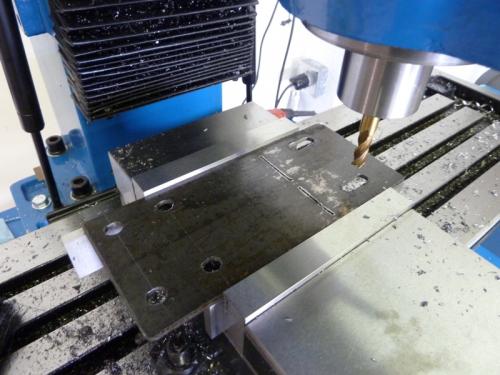
This shows the plate bent 90 deg and held together bu the 3 tabs.
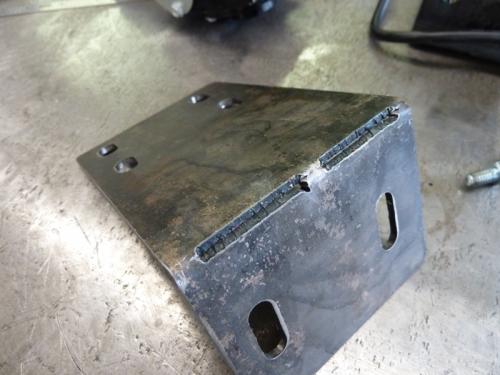
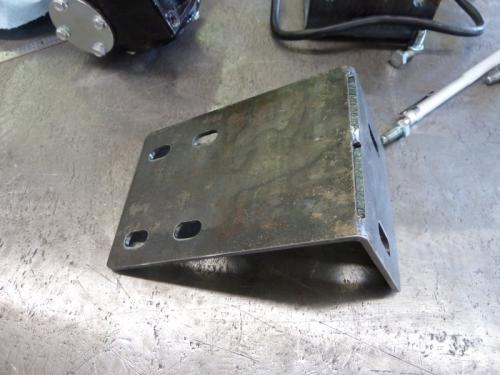
I used a piece of heavy angle to hold the shape during welding.
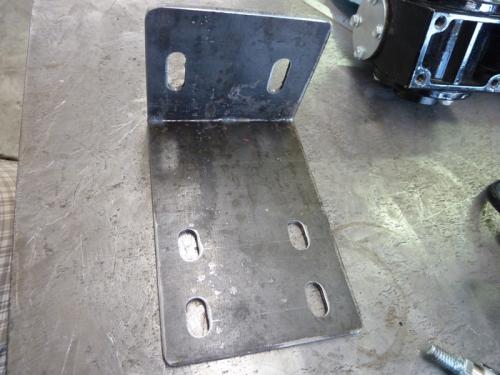
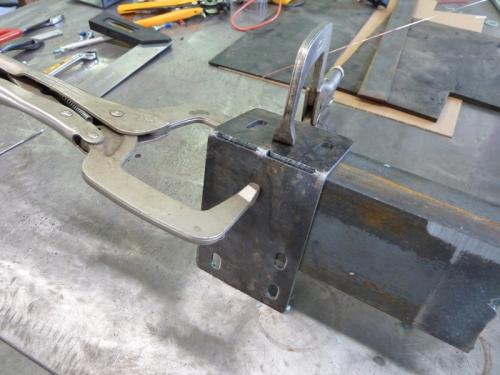
The finished piece.
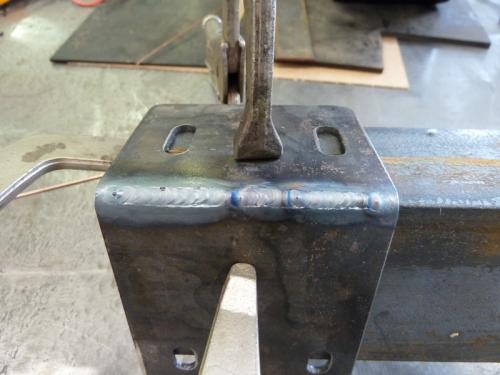
Collecting tools for 30 years.
Posts: 3,002
Threads: 51
Joined: Apr 2012
Location: Ontario
Nice way of bending the brackets Dan. Will have to keep that one in mind. Very clean job on closing it up by the way.
Free advice is worth exactly what you payed for it.
Greg
Posts: 8,739
Threads: 313
Joined: Feb 2012
Location: Arizona/Minnesota
Nice tip Dan. How do you control the depth of the cut with the plasma cutter?
Ed
Posts: 4,513
Threads: 139
Joined: Feb 2012
Location: Kempton Park. South Africa
Dan,
That is a very neat idea


DaveH
Posts: 157
Threads: 18
Joined: Apr 2012
Location: Damascus, Or
Ed,
The plasma cuts all the way through the plate. I used a straight edge clamped to the plate and marked the webs I wanted to leave uncut. A cutoff wheel on a grinder would also work. A mig welder would have also worked to fill in the gaps.
Dan
Collecting tools for 30 years.
Posts: 8,739
Threads: 313
Joined: Feb 2012
Location: Arizona/Minnesota
(08-27-2012, 08:16 AM)DanH Wrote: Ed,
The plasma cuts all the way through the plate. I used a straight edge clamped to the plate and marked the webs I wanted to leave uncut. A cutoff wheel on a grinder would also work. A mig welder would have also worked to fill in the gaps.
Dan
Got it. Thanks!
Ed
Posts: 537
Threads: 15
Joined: Jun 2012
Location: Cambridge, England
I find that it's easy to get all hooked up in which is the "best" welding method. What the real question should be is; On any particular job, which is the most suitable process. As a qualified weld inspector I was forever required to referee the other design engineers when welding questions came up

with many people now convinced that oxy/fuel gas welding is finished and that either MIG or TIG is the "best" choice on anything thin. While these are pretty good assumptions they are far from absolute. There are some basic truths about each process but in almost every case selection of a particular method will be a compromise. For example MIG is fast and TIG is slow, Well that depends on the finish required and the joint preparation as well as the material being used. If you need a nicely finished weld on steel below 0.060" and you can set up the joint so that there's enough material to "run the weld in" TIG can be much quicker than MIG, as MIG will need spatter removal and potentially surface finishing(grinding) Where it is easy to avoid this with the TIG. If you are doing structural iron work in a shop and you have a suitably sized MIG then it's the obvious choice, but same job up a ladder on site and a stick welder makes much more sense. But surely flame welding is over, right? nope, flame is ideal for Nickel/bronze welding of chrome moly tubing giving a stronger fatigue resistant solution for lightweight aviation and racing car frames a process which takes roughly the same time as TIG but lasts much longer and greatly reduces warpage.
So, which set to buy for hobby use? If I could afford only one basic machine it's going to be a dc inverter set. I'm using sticks for anything over 1/8" 3mm and a TIG torch on everything else, if I was then forced to work in Ally I'd go with a propane torch and specialist Ally solder.
Regards
Rick
Whatever it is, do it today, Tomorrow may not be an option and regret outlasts fatigue.
Posts: 8,739
Threads: 313
Joined: Feb 2012
Location: Arizona/Minnesota
Rick,
What's "a dc inverter set"?

Thanks,
Ed











 with many people now convinced that oxy/fuel gas welding is finished and that either MIG or TIG is the "best" choice on anything thin. While these are pretty good assumptions they are far from absolute. There are some basic truths about each process but in almost every case selection of a particular method will be a compromise. For example MIG is fast and TIG is slow, Well that depends on the finish required and the joint preparation as well as the material being used. If you need a nicely finished weld on steel below 0.060" and you can set up the joint so that there's enough material to "run the weld in" TIG can be much quicker than MIG, as MIG will need spatter removal and potentially surface finishing(grinding) Where it is easy to avoid this with the TIG. If you are doing structural iron work in a shop and you have a suitably sized MIG then it's the obvious choice, but same job up a ladder on site and a stick welder makes much more sense. But surely flame welding is over, right? nope, flame is ideal for Nickel/bronze welding of chrome moly tubing giving a stronger fatigue resistant solution for lightweight aviation and racing car frames a process which takes roughly the same time as TIG but lasts much longer and greatly reduces warpage.
with many people now convinced that oxy/fuel gas welding is finished and that either MIG or TIG is the "best" choice on anything thin. While these are pretty good assumptions they are far from absolute. There are some basic truths about each process but in almost every case selection of a particular method will be a compromise. For example MIG is fast and TIG is slow, Well that depends on the finish required and the joint preparation as well as the material being used. If you need a nicely finished weld on steel below 0.060" and you can set up the joint so that there's enough material to "run the weld in" TIG can be much quicker than MIG, as MIG will need spatter removal and potentially surface finishing(grinding) Where it is easy to avoid this with the TIG. If you are doing structural iron work in a shop and you have a suitably sized MIG then it's the obvious choice, but same job up a ladder on site and a stick welder makes much more sense. But surely flame welding is over, right? nope, flame is ideal for Nickel/bronze welding of chrome moly tubing giving a stronger fatigue resistant solution for lightweight aviation and racing car frames a process which takes roughly the same time as TIG but lasts much longer and greatly reduces warpage. 